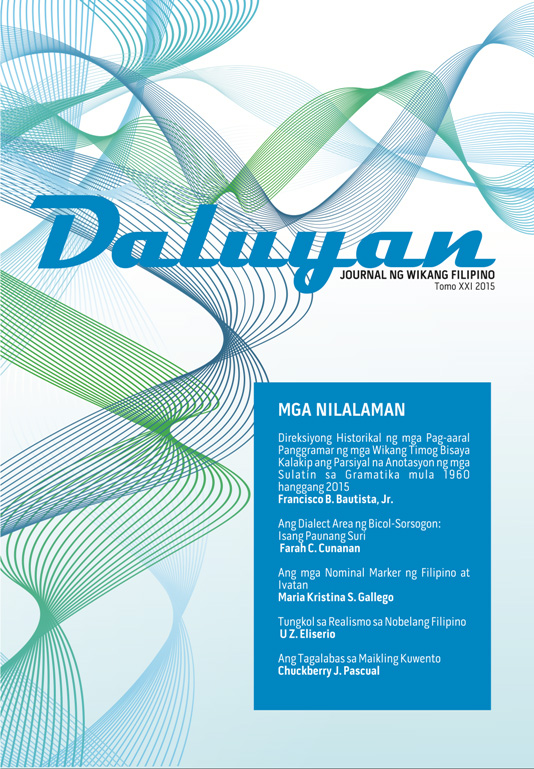Direksiyong Historikal ng mga Pag-aaral Panggramar ng mga Wikang Timog Bisaya Kalakip ang Parsiyal na Anotasyon ng Ilang Sulatín sa Gramatika mula 1960 hanggang 2015
Abstract
ABSTRAK
Sa papel na ito, may pagtatangkang ilahad ang direksiyong historikal ng mga gramatikal na pag-aaral sa mga wikang Timog Bisaya (i.e. Sebwano, Tausug, Surigaonon, Butuanon) mula sa taong 1900 hanggang kasalukuyan. Gamit ang freymwurk ni Gonzales-Garcia (2011) sa pagkaklasipika ng mga meyjor na trend sa Filipino/Tagalog, dinalumat ang kalakhan ng mga lawas ng teksto upang matiyak na ang mga representatibong teksto sa bawat panahon ay
maitatampok. Sa mga wikang nakapaloob sa sangay na pinagaralan, lumalabas na malaki ang diperensya ng mga sulatin ukol sa Sebwano kumpara sa mga kapatid nitong wika. Magkagayunman, kahit ang Sebwano ay nakapagtala rin ng mas kaunting bilang ng pag-aaral kung ihahanay sa mga pangunahing wika sa bansa base sa imbentaryong isinagawa nina Blake (1920), Asuncion-Landé (1971), atbp. kung saan ito ay bumubuo lamang sa 1 hanggang 7 porsiyento ng
lahat ng mga nasarbey na sulatin.
Ipinakita ng paglalahad ng progresong historikal na malinaw ang pagkakasalin-salin ng interes pagdating sa pag-aaral ng wika. Ang naging direksiyon ay mula sa masidhing kagustuhan ng mga misyonero na ipalaganap ang Kristiyanismo
tungo sa mas akademikong lapit ng mga katutubo at dayuhang iskolar. Mayroong iba’t ibang motibasyon ang paglalathala ng mga papel katulad ng pagbuo ng politikal na impluwensiya sa komunidad pangwika at ng komersiyal nitong halaga lalo na kung ang target na mambabasa ay mga dayuhang nag-aaral ng katutubong wika. Upang maging katuwang ng kapwa mananaliksik,
isang parsiyal na anotasyon ng mga piling kontemporaneong sulatin sa gramatika (mula 1960 hanggang kasalukuyan) ang inilakip sa tekstong ito.
Mga susing salita: Sebwano, sangguniang panggramar, annotated bibliography, Timog Bisaya, Philippine linguistics
ABSTRACT
Th is paper presents the historical trajectory of written grammars and researches on South Bisayan languages (i.e. Cebuano, Tausug, Surigaonon, Butuanon) from 1900 until present. It used the operational framework used by Gonzales-Garcia (2011) in identifying major historical trends in grammars produced for Filipino/Tagalog language, with an attempt to access the most relevant texts on the topic that would ensure representativeness of gathered data. It was found that there is a huge numerical margin between grammars written for Cebuano and those for the rest of other South Bisayan languages. Nevertheless, it is interesting to note that despite this huge margin, even Cebuano had accounted for a low number of produced studies or reference grammars when compared to other important Philippine languages, based on the inventories made by Blake (1920), and Asuncion-Landé (1971), among others. These inventories showed that Cebuano-related grammars and researches only comprise 1 to 7 percent of all surveyed texts.
The presentation of the historical trends in the grammars of South Bisayan languages suggests that evident transfers of interest in the conduct of linguistic or language studies for the said language sub-family took place. The direction was from the staunch interest by foreign missionaries to propagate Christian
faith to a more academic approach of foreign and native-born scholars. The individuals who studied these languages had varied motivations for pursuing or publishing their papers, the more prominent ones include the desire to contribute in the exertion of political influence to the involved linguistic community and to harness the commercial value of the reference grammars
especially when the target readers are foreigners who wanted to communicate with locals. To aid in the scholastic efforts of fellow language researchers, a partial annotation of contemporary writings on South Bisayan grammars, from 1960 to the most recent, was attached to this paper.
Keywords: Cebuano, reference grammar, annotated bibliography, South Bisayan, Philippine linguistics


